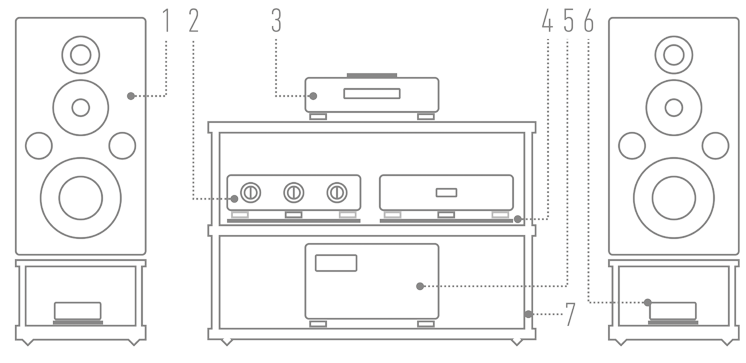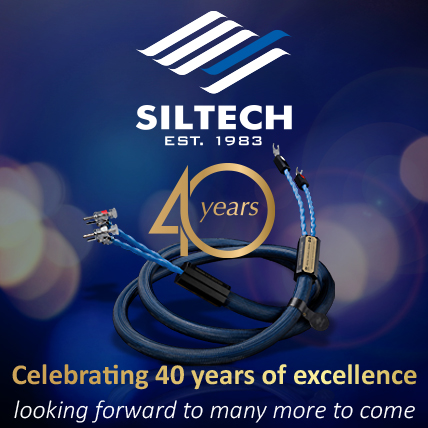|
TURNTABLE & TONEARM J.SIKORA
Manufacturer: J. SIKORA |

|
Review
text WOJCIECH PACUŁA |

|
No 257 October 1, 2025 |
|
˻ PREMIERE ˼ ⌈ J.SIKORA was founded in 2007 in Lublin. At that time, its first turntable, the STANDARD model, was ready. It took seven years to prepare the top-of-the-line REFERENCE, which was unveiled in 2014. In the following years, it was joined by the cheaper Initial deck, and then tonearms. The tested ASPIRE model is an even lower-priced option. We are the first magazine to test it with the new bespoke Aspire tonearm. ⌋ NEVER BEFORE has J.Sikora offered such an affordable turntable as the Aspire. I don't mean “so cheap,” because ‘cheap’ is associated with something uninteresting, but what matters is that the new design opening the lineup of this Lublin-based company from now on belongs to the world of high-end and is priced accordingly. So it is not “cheap” in any sense of the word. 
And yet its development was a big challenge for the company's designers. This is because it was supposed to be a compact, neat turntable with a design acceptable to a larger group of users and their families, but at the same time retaining most of the solutions found in its more expensive, mechanically advanced models. If not directly, then at least scaled down or made slightly differently, but still similar. That was the case with the deck. With the tonearm, the matter proved even more difficult. Initially, the idea was to equip the Aspire with an OEM tonearm manufactured by one of the Asian producers, for example, from Taiwan. And, as the company's manager Robert Sikora says, it sounded really good. However, somewhere in the back of his head, the “what if...” bug appeared. Buying tonearms from external companies involves many challenges, both in terms of design and logistics. Besides, wouldn't it be better to offer a complete product, tuned from A to Z by JSikora? And so the Aspire tonearm came to be. It looks identical to the KV 9 and shares many of its components. It features the same forward-tapered braided tube, made in-house, the same head-shell and uni-pivot bearing housing, as well as the same bearing. However, the materials used to make some of the components are different. Thanks to the persistence of the little bug I mentioned, we get a turntable that looks great, is superbly built, and has “by J. Sikora” written all over it. And that's really something. ▌ Aspire UNTIL NOW, THE OFFER OF THIS LUBLIN-BASED COMPANY ranged from the powerful Reference turntable to the basic model called Initial. Between them, we could find the Standard series. Both the Standard and Initial turntables could be upgraded to Max versions. With the transition to a higher series, and within it to a more advanced version, the manufacturer added more weight to the construction. Let us remind you that this company's turntables are non-decoupled mass-loaders, in which vibrations and resonances are dampened by a large mass and a combination of different types of metals. So when the company started thinking about an even cheaper model, it was clear that weight reduction would be necessary. Contrary to appearances, this was a greater challenge than adding weight. All the more so because they wanted to retain all the basic advantages and features of the company's “large” decks. In the end, a large part of the solutions, and even components, in the Aspire come from the more expensive J.Sikora designs, and the company had to design its tonearm from scratch because the offerings from OEM manufacturers did not quite meet their expectations. ▲ A few simple words… ROBERT SIKORA 
⸜ Robert Sikora presenting the new Aspire tonearm THE DESIGN OF THE ASPIRE is based on all the key components proven in the higher-end, award-winning and internationally recognized J.Sikora turntable models, and its construction is based on the key principles of our brand's philosophy. For this deck we used a platter known from the Initial series, made entirely of Delrin, as well as an inverted bearing with a ceramic ball, a microprocessor controller, and a PAPST DC motor used in all turntables of this brand. The bearing is made of hardened stainless steel, and the zirconium dioxide ball contacts a sintered carbide plate. The turntable base is a solid PA6 aluminum plate. The motor, controller, and wiring cover are made from a solid block of the same material (with minimal, necessary milling). To reduce unwanted vibrations and resonances, the bearing is mounted on a centimeter-thick cast iron plate, and the motor is bolted to the base using vibration-damping elements. The adjustable anti-vibration turntable feet are also a feature known from higher-end models: a steel spike with a ceramic ball (also made of zirconium dioxide) screwed to the base with a threaded brass shaft, mounted on an aluminum plate with silicone pads. This gives the Aspire exceptional rotational stability, complete isolation from external resonance, and the sound of the J.Sikora family of turntables, which is so highly regarded around the world. And then there is the tonearm... The Aspire tonearm is a model designed specifically for use with the Aspire turntable. Its design is based on the world-renowned Kevlar tonearms of the KV and KV Max series, and like its predecessors, it is a uni-pivot design with oil damping. The tonearm is constructed from aluminum, stainless steel, and brass, and the tapered tube is made of carbon fiber and a special foam used in higher-end models. The arm wiring (a single section from the pins in a head-shell to the RCA plugs) uses pure copper conductors, while the insulation and shielding of the wires is an original design by J. Sikora. Cheaper and easier to process materials have allowed for a significant reduction in the cost of manufacturing the arm, while remaining faithful to the brand's philosophy and the sound character known from the higher KV series arms. 
⸜ Adam Niezbecki at work The turntable will be available in three price variants: €5,900 for the deck, €7,500 for the deck with the J.Sikora Aspire tonearm and basic power supply, and €9,800 for the deck with the J.Sikora KV9 Kevlar tonearm and linear power supply. It will also be possible to purchase individual upgrades available for Initial line turntables. RS The ASPIRE model, both the deck and the tonearm, is a breakthrough in this manufacturer's range. All the more so because it is the first design created from scratch not by Janusz Sikora, the founder and head of the company, who is now enjoying semi-retirement, but by his son Robert and the good spirit of the company who always sets up its turntables, Adam Niezbecki. So you can imagine how uncertain they are as they wait to see how the market will receive their first “baby.” DECK • Robert has already provided most of the information about the design of the deck in the text above, so I will limit myself to repeating the most important points and adding my own impressions. The most important thing is that the Aspire is a non-decoupled, heavy turntable. Although small, measuring 430 x 350 x 180 mm, it weighs a hefty 21 kilograms, four of which are accounted for by the Delrin platter. The redesigned, smaller record clamp is made of stainless steel. As Janusz Sikora told us during the Initial Max model test, it is very “sticky” to work with and is a material that, unlike hardened steel, for example, does not “ring”. Its structure is doughy and very difficult to work with because it “sticks” to the knife. 
Returning to Derlin, let us add that it is one of the brand names for polyoxymethylene (POM), a thermoplastic organic chemical compound widely used in industry; other names include Ertacetal, Tecaform, and Boracetal. It was invented in 1952 by German chemist Hermann Staudinger, who would receive the Nobel Prize in Chemistry a year later. It was developed for industrial use in 1960 by the American company DuPont, the same company that gave us Teflon, Kapton, and other materials used in audio. The main bearing is a steel axle mounted in a kind of large-diameter cast iron “flange.” At the end of the shaft is a ceramic ball that works with a sintered carbide bearing mounted in a plate. The torque from the motor to the plate is transmitted by a single rubber belt with a square cross-section. On one side, it wraps around the shaft mounted on the motor axle, also made of Derlin, and on the other side, it wraps around the platter. The base is made of a single piece of aluminum, anodized and coated with lacquer. It looks very good. The upper part features control buttons for changing the rotation speed and turning the drive on and off. However, there is no display. To be honest, it looks even better this way. Perhaps it would be useful to have some indication of the selected speed. An elongated cuboid, which is an aluminum cutter containing the control electronics and motor, is screwed onto the bottom. The company programs the electronics specifically for its turntables and the motors used. The Aspire has a single motor, which is a direct current (asynchronous) motor from EBM-Papst. It is attached to the base by means of a cast iron element. As Adam said, it took a long time to completely eliminate its vibrations, because it is a much lighter turntable with a single base. Now, he adds, even a stethoscope will not reveal anything alarming. TONEARM • The Aspire arm is a new design by J. Sikora, but conceptually it is a variation on the KV9 arm. It is a uni-pivot arm with oil damping. The tube is made of conically molded carbon fiber. As Robert mentioned, eliminating Kevlar resulted in a 50% weight reduction for the entire arm (!). However, the inside is filled with the same foam as in more expensive models. The change of used materials has resulted in a reduction in the total weight of the arm – the KV9 Zirconium Series weighs 245 g, while the Aspire weighs just 160 g. On the other hand, the effective weight has increased slightly, from 10.7 g to 11.2 g – but Kevlar has its advantages. This means that, in theory, it will work with a smaller range of modern cartridges with higher compliance. In reality, this may not matter much. The effective arm length remains unchanged at 228.6 mm; it is a 9" design. The aluminum housing remains the same, as does the head-shell. However, the element that comes into contact with the pivot has been replaced from cast iron to brass. The cables are also different. Instead of Soyaton copper-gold wires, this time the manufacturer used oxygen-free copper cabling, to which the company applies Teflon tubes and vibration damping elements. Gold-plated RCA plugs have also been specially selected for these cables. As the designers said, it was not a simple matter, because even such a small element changes the sound. Let's add that user can adjust both the VTA and the azimuth for the arm – the counterweight has an off-center hole so that its mass is lower than the spindle on which it is suspended. We change the VTA in the classic way, by unscrewing the Allen screw that secures the arm column to its bed. 
It is a beautiful, seemingly simple design, which is sophisticated. One can order it without an arm, with an Aspire arm, or with a KV9. Prices: €5,900 for the deck alone, €7,500 for the turntable with the J.Sikora Aspire tonearm and basic SMPS power supply, and €9,800 for the turntable with the J.Sikora KV9 Kevlar tonearm and linear power supply. There will also be the option to purchase upgrades available for the Initial line of turntables. ▌ SOUND HOW WE LISTENED • The J.Sikora Aspire turntable was tested in the HIGH FIDELITY reference system and placed on the top shelf made of carbon fiber of the Finite Elemente Master Reference Pagode Edition Mk II rack. During the turntable tests, I listened to it with a Miyajima Laboratory Destiny cartridge (review → HERE). I used DS Audio ST-50, a solidified gel for cleaning the stylus. |

I also used the RCM Audio Sensor Prelude IC phono preamplifier, that received signal via the Crystal Cable Absolute Dream interconnect. I connected the preamplifier to the Nordost QKORE6 artificial ground (more → HERE). » RECORDS USED FOR THE TEST ⸜ a selection
⸜ KRAFTWERK, Tour The France Soundtracks, EMI Records 591 708 1, 2 x 180 g LP ⸜ 2003. I GOT TO LIKE THIS TURNTABLE even before I heard it. It is obvious that I am attracted to (we are attracted to) complex systems, powerful products, intimidating designs, overwhelming devices, and speakers. However, this does not mean that we would like to have them. And in the case of Aspire, the level of “wanting” will be high. Because it is such a neat device, because it is so well made, and – finally – because it sounds so beautiful. 
And although the turntable evoked warm feelings in me just by standing there and smiling at me, when I heard the first sounds from A-1 Prolog to the album Tour The France Soundtracks by KRAFTWERK, when in < b>A-2 Tour de France Étape 1 that low, warm, pulsating bass came in, my “liking” turned into respect. And that's how I felt until the end of the listening session. There is something about this design that makes everything “work” and “fit together”, and we don't have to tense up or stress about anything. The Aspire with the Miyajima Labs cartridge sounded extremely smoothly. Not too smoothly, it didn't eliminate details or kill selectivity. But after listening to any album for a moment, we know that this design is moving further in the direction that was once pioneered by decoupled designs such as the Roksan Xerxes or Linn Sondek LP12. That is, in the direction of drive, but more subtle, rather than defined by a hard beat or a clear contour of attack. And yet it is also present in this presentation. Without it, the rhythm set by the electronic pulse of the drums, equivalent to a kick drum, would not have pulled the whole thing together in the way it did with Aspire. And I didn't even have to sit in the “sweet spot” alone, with the curtains drawn, as I do when I listen. The “liking” I mentioned came to me when Robert Sikora and Adam Niezbecki, who was setting up the turntable, sat down on the sofa in front of the speakers, and I stood behind them, by the wall. The conditions were, let's say, not very “listening-friendly”. But right away, even then, I’d heard what I would later confirm. The turntable from Lublin is also capable of effectively dampening the energy of pops&cracks. This is a special type of signal – an interference signal – with a very fast attack and short duration. Decoupled designs cope with this very well, because the lossy components nicely round off the attack, making the cracks seem less intrusive. I believe that the Aspire goes even step further and does it almost as well as the large, heavy turntables from this company. I bought the Kraftwerk's album as soon as it came out, so it's the first edition. Regularly cleaned, kept in an anti-static sleeve, etc. – everything is as it should be. And yet, there are a few spots on it with cracks at the beginning. Whether it's a particularly troublesome speck of dust or a manufacturing defect, I don't know, but I've gotten used to it. With the J.Sikora turntable, this problem was minimal. It was still there, but now it was “under” the music, not even “next to” it. It was as if the turntable was able to cope with this type of interference without dampening the energy of the music itself. I checked it out right after that by listening to the first stereo LP in the history of phonography, released in 1956 by THE DUKES OF DIXIELAND, entitled …You Have To Hear It To Believe It!. It is an incredible recording because it is truly stereophonic. In those days, mixes did not feature a panorama function, and those converted to stereo offered a left-center-right switch. That is why records from the 1950s and 1960s sound the way they do. However, the album I am talking about sounds as if it was recorded with a stereo microphone (or two in such an arrangement), without the need for such a switch. But to the point – this is an album with exceptional dynamics. You know – a Dixieland band, a good Dixieland band, a great recording, etc. The very first beats of the snare drum at the beginning of the first track on the album, A-1 South Rampat Street Parade, gave me an idea of the speed with which the Aspire turntable reproduces sound. It is dynamic, energetic and “wide” presentation. That is, it is a sound in which no limitations are felt and which, thanks to this feature, allows the music to unfold before us in an unrestricted manner, whether dynamically, in tonal terms, or spatially. All these advantages can also be heard in recordings that we are ashamed to share with our friends and fellow audiophiles, but which we listen to at parties and which are usually the most popular at such events. For me, one such album is the original Hansa release of BONNEY M's Take The Heat Off Me. Released in 1976, it features such hits as Daddy Cool, Sunny and a cover of Bob Marley's No Woman No Cry. When the male voice in the opening track A-1 Daddy… sang, “She's crazy like a fool / Wild about Daddy Cool”, it sounded thrilling! Disco, disco ball, sequins, heavy makeup, and feathers—all of this was in that short intro, and it was all in the right place. Aspire communicates such things casually, as if by accident. But not dispassionately—oh no! It is a turntable that differentiates all elements of the performance. An interesting fact is that although Bobby Farrell was the main male voice in the band, it is Frank Farian, the band's producer, who can be heard singing on this particular recording. When, after A-1 Daddy…, I listened to A-2 Take The Heat Off Me, and then A-3 Sunny, it was clear that the first and third tracks are super dynamic and energetic, while the title track between them sounds somewhat flat. The orchestra accompanying NAT ‘KING’ COLE on the Just One Of Those Things, released in 1957 and remastered by S&P Records in 2004 on 180-gram vinyl using an analog process, also sounded extremely dynamic. 
What a wonderful record, what a wonderful reissue! What a wonderful turntable! – It must be added right away. Aspire can instantly switch from piano to forte and back again without sounding forced. It presents a large volume and plays low, saturated bass. If it were just fast playing, such an ability to differentiate dynamics would not be so interesting. But here, the changes are instantaneous while maintaining the full range. You can even hear production decisions, such as the boost at the beginning of the verses in A-1 When Your Love Is Gone. Immediately afterwards, the orchestra quiets down, as does Cole's vocals. The idea was to strike, retreat, and then slowly raise the temperature after a while. With J. Sikora's turntable, we can hear it clearly. The most important thing about all this, in my opinion, is that it is a very reliable design. The same applies to all turntables and tonearms from this company, but I have this gut feeling, this subconscious “something” that I had with turntables such as TechDAS, Kuzma, SME, and Dr. Feickert Analogue, which I interpret as an inner peace regarding the behavior of the device in various conditions, with different records, cartridges, and phono preamplifiers. This feeling of “being taken care of” is the result of technical choices, and therefore performance, but also something more, something that goes towards combining small fragments together into a work of art. And even if the recording is not entirely tonally balanced – whether it's GARBAGE with BRIAN AUBERT from the 10" record entitled The Chemicals, whose sound leans heavily towards noise, or John Lennon's Imagine, reissued in 2011, which is heavily compressed and somewhat closed at the top of the range, it doesn't turn into a nervous breakdown. I listened to these albums with great pleasure because I like this music and it gives me joy. And that's exactly what it is – joy – that comes with the Aspire in one package with dynamics, resolution, and resistance to mechanical interference from the vinyl itself. Perhaps this is why Aspire delivers equally well large orchestras and small, intimate recordings. The latter are slightly boosted slightly increased volume. The fact is that this setup (cartridge + preamplifier) attempts to reproduce the large scale of the room, reverberations, and powerful bass. When the harpsichord plays, it is not booming, but there is something “anointed” in the sound – that's how I hear it – which makes it not a comma, but an exclamation mark combined with an ellipsis – I hope you know what I mean. HELMUT WALCHA, who plays this instrument on an album with Bach's works, released in Japan by Angel Records on transparent red vinyl, sounded dignified and powerful, based on a low, deep base. The instrument itself retained the character of a small hammered instrument, but it also had a certain dignity about it. Aspire deepens the sound, complementing it without going overboard or becoming a caricature. ▌ Summary I LIKE, VERY MUCH this turntable. It gives me a lot of fun and joy, it doesn't interfere with listening, but helps. At the same time, it is exceptionally balanced in what it shows, because it does not favor specific releases or music. It informs listener about better and worse quality reissues and pressings, differentiates between album productions – it is a very selective device. However, it is somewhat conservative in this respect, rather – I repeat – informing than shouting loud about it. 
The Aspire is a device with a magnificent design, truly high-end performance, and yet compact body. This is great news for everyone who found even the Initial model, previously the one opening J.Sikora's price list, unacceptable, or whose housemates were unconvinced and impossible to appease. Aspire should reconcile them all, because it is an awesome turntable in every respect. And it is a beautiful example of transferring expensive, top-of-the-line solutions to a level acceptable to a wider group of music listeners, and so it fully deserves our ˻ RED FINGERPRINT ˺. ● ▌ Technical specifications (according to the manufacturer)
» DECK 
THIS TEST HAS BEEN DESIGNED ACCORDING TO THE GUIDELINES adopted by the Association of International Audiophile Publications, an international audio press association concerned with ethical and professional standards in our industry, of which HIGH FIDELITY is a founding member. More about the association and its constituent titles → HERE. |

|
Reference system 2025 |
|
 1) Loudspeakers: HARBETH M40.1 |REVIEW| 2) Line preamplifier: AYON AUDIO Spheris III Linestage |REVIEW| 3) Super Audio CD Player: AYON AUDIO CD-35 HF Edition No. 01/50 |REVIEW| 4) Stands (loudspeakers): ACOUSTIC REVIVE (custom) |ABOUT| 5) Power amplifier: SOULUTION 710 6) Loudspeaker filter: SPEC REAL-SOUND PROCESSOR RSP-AZ9EX (prototype) |REVIEW| 7) Hi-Fi rack: Hi-Fi rack: finite elemente MASTER REFERENCE PAGODE EDITION Mk II, more → HERE |
|

|
Cables Analog interconnect SACD Player - Line preamplifier: SILTECH Triple Crown (1 m) |ABOUT|» ANALOG INTERCONNECT Line preamplifier → Power amplifier: Siltech ROYAL SINLGE CROWN RCA; review → HERE Speaker cable: SILTECH Triple Crown (2.5 m) |ABOUT| |

|
AC Power Power cable | Mains Power Distribution Block - SACD Player: SILTECH Triple CrownPower (2 m) |ARTICLE| » POWER CABLE Mains Power Distribution Block → Line preamplifier: Acoustic Revive ABSOLUTE-POWER CORD, review → HERE » POWER CABLE Mains Power Distribution Block → Power amplifier: Acoustic Revive ABSOLUTE-POWER CORD, review → HERE Power cable | Power Receptacle - Mains Power Distribution Block: ACROLINK Mexcel 7N-PC9500 (2 m) |ARTICLE| Power Receptacle: Acoustic Revive RTP-4eu ULTIMATE |REVIEW| » ANTI-VIBRATION PLATFORM under Acoustic Revive RTP-4eu ULTIMATE: Graphite Audio CLASSIC 100 ULTRA, review → HERE Power Supply Conditioner: Acoustic Revive RPC-1 |REVIEW| Power Supply Conditioner: Acoustic Revive RAS-14 Triple-C |REVIEW| Passive filter EMI/RFI: VERICTUM Block |REVIEW| |

|
Anti-vibration Speaker stands: ACOUSTIC REVIVE (custom)Hi-Fi rack: finite elemente MASTER REFERENCE PAGODE EDITION Mk II, more → HERE Anti-vibration platforms: ACOUSTIC REVIVE RAF-48H |ARTICLE| » ANTI-VIBRATIONAL FEET: |

|
Analogue Phono preamplifier: Phono cartridges:
Clamp: PATHE WINGS Titanium PW-Ti 770 | Limited Edition Record mats:
|

|
Headphones » HEADPHONE AMPLIFIER: Leben CS-600X, review → HEREHeadphones: Headphone Cables: Forza AudioWorks NOIR HYBRID HPC |
main page | archive | contact | kts
© 2009 HighFidelity, design by PikselStudio,
projektowanie stron www: Indecity





























